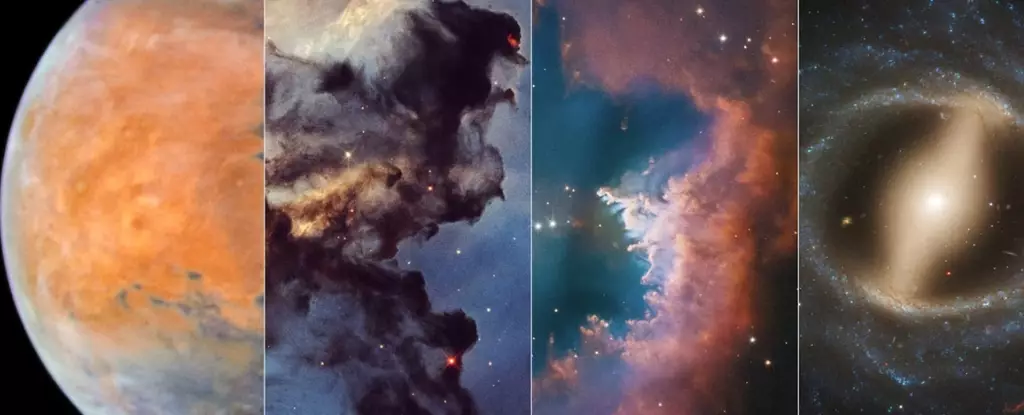This week marks a significant milestone in the realm of space exploration: the 35th anniversary of the Hubble Space Telescope. Launched on April 24, 1990, aboard the Space Shuttle Discovery, Hubble has transformed our understanding of the cosmos. Rather than resting on its laurels, the team behind Hubble has chosen to gift us with stunning new images, showcasing the telescope’s expansive capabilities. With every anniversary, we not only celebrate its achievements but also reflect on the invaluable contributions it has made to astrophysics and astronomy.
The potential of the Hubble Space Telescope was nothing short of revolutionary. Astrophysics Division’s acting director, Shawn Domagal-Goldman, articulated this sentiment perfectly, noting that Hubble opened a “new window to the universe.” Its operational status after three and a half decades directly speaks to the importance of well-maintained flagship observatories in advancing our scientific horizon. Furthermore, the insights gleaned from Hubble’s long tenure provide foundational knowledge as we prepare for ambitious upcoming initiatives like the Habitable Worlds Observatory.
Overcoming Early Challenges
However, Hubble’s journey was fraught with difficulties right from the start. The observatory encountered a significant setback due to a critical flaw in its primary mirror, which hampered its imaging capabilities. Furthermore, initial operations revealed that the telescope could not deliver the crystal-clear images it was designed to produce. In response, NASA initiated a series of servicing missions, the first of which took place in 1993 and involved astronauts installing corrective hardware. This pivotal moment not only salvaged Hubble’s mission but laid the groundwork for the groundbreaking discoveries that would follow.
Since that turning point, Hubble has gone on to redefine numerous facets of astronomy. From mapping the passage of celestial bodies to unraveling the mysteries surrounding black holes, its discoveries have fundamentally shifted our comprehension of the universe. The telescope has helped piece together the cosmic puzzle regarding dark energy and the universe’s accelerated expansion, thus molding our present understanding of astrophysical phenomena.
A Storehouse of Insights
To date, Hubble has amassed a staggering catalogue of nearly 1.7 million observations supporting over 22,000 research papers. These statistics reveal not only the expansive reach of the telescope but also its profound influence on both scientific communities and public interest alike. Hubble’s vivid images have vividly illustrated the universe’s grandeur, making astronomical phenomena accessible to the general audience and igniting popular fascination with outer space.
Despite the tragic loss of the Space Shuttle Columbia and its crew in 2003, which led to pauses in critical repairs, Hubble’s tenure was rejuvenated through public support and renewed commitment from NASA. The final servicing mission in 2009 marked another watershed moment. NASA’s initial expectation of just a few additional years for Hubble has since blossomed into an unprecedented 16-year operational period devoid of any repairs, showcasing the telescope’s resilience and adaptability.
A Glimpse Into the Stars
Recently released images further emphasize Hubble’s capabilities. Captures of Mars taken in late December showcase the planet’s distinct features, including the Tharsis plateau and the north polar ice cap, illuminating the intricate tapestry of our neighboring planet. An intriguing view of the Rosette Nebula depicts the ongoing processes of star formation, highlighting the beauty that darkness and dust can offer in the cosmic arena.
Additionally, Hubble’s recent observations of the planetary nebula NGC 2899, reminiscent of a cosmic moth, display the intricate dance of color and light formed by gases and dust expelled by its central star. Another significant observation involves the spiral galaxy NGC 5335, where a bar-shaped structure channels gas towards its core, fostering the birth of new stars. This visual narrative not only showcases Hubble’s technical prowess but also reiterates its role as a storyteller for the cosmos.
The Future of Cosmic Exploration
As Hubble continues to break new ground, it is not free from challenges. Periodic malfunctions underscore that its operational lifespan is finite. At the same time, a new player is drawing attention: the James Webb Space Telescope (JWST), which boasts seven times Hubble’s light-gathering capacity. Unlike Hubble, JWST primarily observes the universe in infrared light, expanding our observational palette. However, its million-mile distance from Earth renders it unserviceable, contrasting sharply with Hubble’s historic on-orbit repairs.
Future missions like the Habitable Worlds Observatory promise to build upon Hubble’s legacy while achieving even greater clarity in cosmic imaging. Planned with robotic servicing in mind, HWO aims to explore potentially habitable Earth-like planets orbiting distant stars, thereby pushing the boundaries of our search for life beyond Earth. By the time HWO is expected to launch in the 2040s, it will endeavor to provide images sharper than Hubble’s, illuminating the cosmos in unprecedented ways.
Hubble’s lasting impact is undeniable, and as we celebrate its accomplishments, we also stand poised to embark on new adventures that will further our quest to understand our universe.

